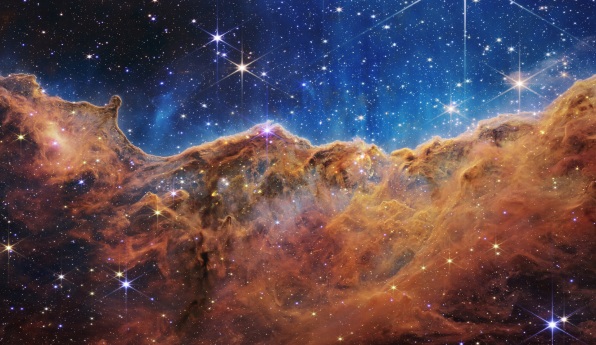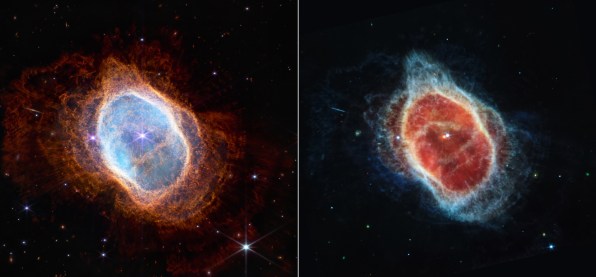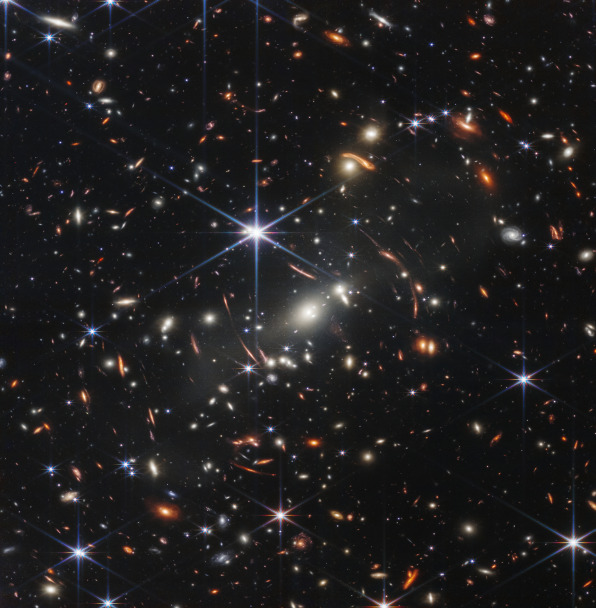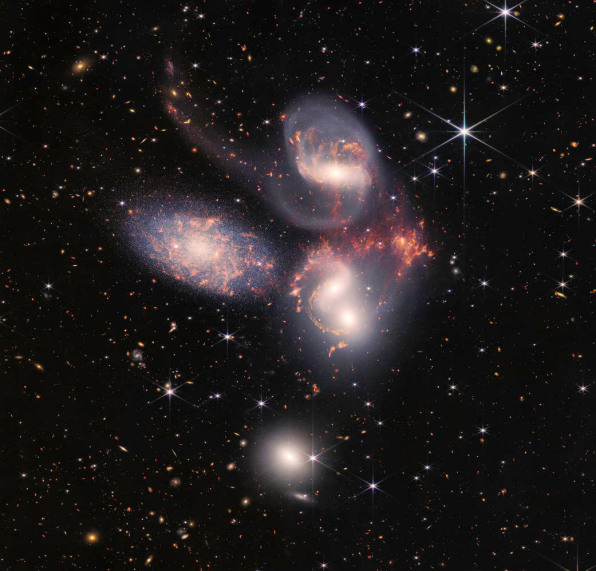- | 9:00 am
The first photos from NASA’s Webb telescope are already changing how we view the universe
NASA’s $10 billion space observatory images exceed expectations, promising to reveal more secrets of the universe over the next two decades.

Three and a half decades of nearly insurmountable technical and funding hurdles bore fruit in full-color glory as NASA unveiled its first public images and spectroscopic data this week from the James Webb Space Telescope.
The White House set the astronomy world abuzz on Monday night when it previewed the first image: an expanse of galaxies in one of astronomy’s deepest viewings of the universe. Then on Tuesday, an international lineup of project leaders and mission partners revealed even more breathtaking cosmic images in a livestreamed event from the Goddard Space Flight Center in Green Belt, Maryland. They included massive galactic clusters and nebulae in kaleidoscopic color and unprecedented detail.
One graphic offered a stunning spectral examination of a Jupiter-like exoplanet, whose atmosphere appeared to reveal the existence of water vapor. Other Technicolor images displayed how the telescope is able to penetrate the cosmic dust swirls to reveal the formation of new stars, dust cloud typography, temperature fluctuation, and molecular variations—abilities that eluded its predecessor, the Hubble Space Telescope. Scientists were blown away by the brilliance of the first images and what they can reveal about the nature of the universe. NASA plans to release test shots of Jupiter and its moons on Thursday. And they stress that this is just the beginning.

“These are things I’d never dreamed we could see,” Goddard director Dennis Andrucyk gushed in giddy excitement during Tuesday’s event.
NASA administrator Bill Nelson added, “Eventually, we’ll look back 13.5 billion years, a few million after the Big Bang—that’s the threshold we are crossing. We’re determining the questions we don’t even yet know to ask.”
President Joe Biden and Vice President Kamala Harris lauded the mission, which engaged 20,000 scientists and engineers from 24 countries, as a shining example of international collaboration and among humankind’s greatest engineering achievements.
“Now we enter a new phase of scientific discovery building on the legacy of Hubble,” Harris said. “The James Webb Space telescope allows us to see deeper into space than ever before and in stunning clarity. It will enhance what we know about the origins of our universe, our solar system, and possibly life itself.”
The release of the images marks the beginning of the mission’s scientific objectives—to better understand how galaxies, stars, and planets formed over time and whether planets orbiting other stars might offer conditions to support life. From an orbit a million miles beyond Earth, the $9.7 billion space observatory will capture and analyze traces of infrared light from the formation of the first stars and galaxies 13.5 billion years ago, some 200 million years after the Big Bang. It is 100 times more powerful than the Hubble, which has been able to capture the light from distant galaxies that shone 800 million years after the Big Bang.
Closer to home, its four onboard instruments will examine the atmospheres of rocky planets like ours orbiting nearby stars to determine their suitability for life, as well as the makeup of our solar system’s planets. NASA added this goal after discovering the first exoplanets in 1992, six years into the telescope’s design; today, it’s confirmed more than 5,000 exoplanets.

The Space Telescope Science Institute (STScI), the JWST’s mission operations center, has already awarded telescope time to teams through a competitive process that drew more than 1,000 proposals from 44 countries for the first year of observations. Thanks to a precise launch and trajectory, it reserved enough onboard fuel to support 20 years of research, double the anticipated mission length, which will enable more in-depth science than previously anticipated.
Astronomer Garth Illingworth, the last remaining original Webb architect still working on the mission, said the capabilities exceed the developers’ wildest expectations when they began brainstorming the telescope in 1986.
“Every time I see these images, I’m more blown away,” he told Fast Company. “The Webb is Hubble on steroids. Astronomers will be working on these images for ages. There’s such incredible detail, depth, and information spread across all these different instruments. This is just a few days’ worth of observation; we have a year of it coming up.”
AN ARDUOUS JOURNEY
The telescope finally launched last Christmas after a 35-year against-all-odds struggle through technological mishaps, political infighting, ballooning budgets, near-cancellations, and a pandemic. A month later, it reached its perch in orbit at L2 (the second Lagrangian point), where the combined gravitational pull of the Earth and sun enable the observatory to move with the Earth around the sun while pointing its mirror outward to view the universe.
The ensuing six months saw NASA aligning the telescope’s 18 hexagonal mirrors and calibrating its instruments, teasing its progress along the way. It announced its first targets just last week while staying maddeningly tight-lipped on details. “The CIA would be proud,” Illingworth quipped.
Scientists took the images from well-studied targets—whittled from a short list of 70 for their beauty and ability to showcase Webb capabilities—over a few days at the end of June in invisible infrared. A 30-member team then translated that data into visible colors, cleaning it up at the pixel level. The results rendered them speechless.
“It’s an emotional moment when you see nature suddenly releasing some of its secrets,” Thomas Zurbuchen, associate administrator of NASA’s science mission directorate, said during a June 29 press conference, likening it to the overwhelm he felt as a grad student making a discovery at 2 a.m. “It’s not an image. It’s a new world view.”
JWST operations project scientist Jane Rigby was overcome. “I went and had an ugly cry,” she said during Tuesday’s post-event press conference. “It was a combination of giddy in the room, looking at the data, then going and having a little sob because it works.”
WEBB’S FIRST TARGETS
Representatives from NASA, its mission partners at the European Space Agency and Canadian Space Agency, and STScI spent five years deciding what subjects to look at and unveil first. “There is a long history of looking at a wide range of objects with Hubble and so we have a good idea of what would be spectacular,” Illingworth said.

The image released Monday night, SMACS 0723, shows an area where massive galaxies magnify and distort the light of objects behind them, enabling deep views into distant and faint galaxy clusters. The assault of colorful galaxies represents a point in the universe the size of a grain of sand from Earth’s vantage point. Although the foreground objects are 4.6 billion light-years away, the gravitational forces of the galaxies and dark matter bend the light of objects from behind, enabling the illusive appearance of galaxies more than 13 billion light-years away. Seeing how galaxies evolve over time might also offer clues to the role that dark matter plays.
The Webb image of the Carina Nebula, an interstellar gas cloud 7,600 light-years away, reveals the processes of star formation, stellar nurseries, and individual stars that were previously obscured, as well as a landscape of “cosmic cliffs” and valleys that showcase the Webb’s ability to peer through cosmic dust.
Its view of the Southern Ring Nebula shows a dying star’s final act through the pattern of gas and dust it expels. The star is nearly half a light-year in diameter and some 2,500 light-years from Earth and locked in orbit with a brighter one. The Webb reveals the dimmer star is cloaked in dust, while its spectrograph can decipher the molecules present.

The image of Stephan’s Quintet is a visual grouping of five galaxies, ranging from 40 to 290 million light-years away in the Pegasus constellation, that engage in repeated close encounters. Tight groups like this may have been more common in the early universe. Chronicling their interactions with images this precise—more than 150 million pixels and constructed from almost 1,000 separate files—may provide new insights into how galaxies evolved.
One graphic offered a spectral breakdown of the atmosphere of WASP-96b, a giant gaseous planet 1,150 light-years away that’s half the mass of Jupiter and orbits its star every 3.4 days. Instruments on the spacecraft determine the chemical compositions of exoplanet atmospheres by measuring infrared light fluctuations from parent stars as their planets cross in front of them. The change wavelengths correspond to different elements. Although this world is too hot for life, chemical compositions might offer clues as to which exoplanets could potentially be habitable for humans.
Scientists are excited to dig in and start exploring. “These are practice runs,” says JWST program scientist Eric Smith. “We’re already making discoveries and really haven’t started trying yet.”








































